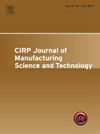Exploring multi-couple field modelling and simulation for surface roughness in MRSTP of blade tenons using shear thickening effect and magnetohydrodynamics
IF 4.6
2区 工程技术
Q2 ENGINEERING, MANUFACTURING
CIRP Journal of Manufacturing Science and Technology
Pub Date : 2025-03-04
DOI:10.1016/j.cirpj.2025.02.006
引用次数: 0
Abstract
Magnetorheological Shear Thickening Polishing (MRSTP) has emerged as a promising technique for achieving nano-level surface quality. This study investigates the dynamics of MRSTP applied to the complex geometries of turbine blade tenons, made of Inconel-718. A theoretical model was developed to predict surface roughness during MRSTP, by integrating experimental and simulation data. The model is based on surface generation principles and accounts for shape changes into a Gaussian cone during material removal. It integrates hydrodynamics, rheological properties of the MRSTP media, and magnetic field effects along with plastic indentation theory. Computational fluid dynamics simulations were used to analyse wall shear stress, and results were incorporated into the theoretical model. A custom magnetic field generation device was designed and MRSTP media was prepared in-house. A series of MRSTP experiments were conducted to validate the model, measuring and analysing surface topographies to align with the proposed mechanism. The experimental validation revealed that the model accurately predicts transient roughness reduction with errors ranging from 4.2 % to 7.9 % for experimental results and 3.4 % to 7.5 % for theoretical to experimental errors. The MRSTP process effectively removed all scratches from the surface within 90 min, demonstrating substantial improvements in surface quality, reduced roughness, and emphasizing the need to adapt machining parameters for different materials.
求助全文
约1分钟内获得全文
求助全文
来源期刊

CIRP Journal of Manufacturing Science and Technology
Engineering-Industrial and Manufacturing Engineering
CiteScore
9.10
自引率
6.20%
发文量
166
审稿时长
63 days
期刊介绍:
The CIRP Journal of Manufacturing Science and Technology (CIRP-JMST) publishes fundamental papers on manufacturing processes, production equipment and automation, product design, manufacturing systems and production organisations up to the level of the production networks, including all the related technical, human and economic factors. Preference is given to contributions describing research results whose feasibility has been demonstrated either in a laboratory or in the industrial praxis. Case studies and review papers on specific issues in manufacturing science and technology are equally encouraged.
 求助内容:
求助内容: 应助结果提醒方式:
应助结果提醒方式:


